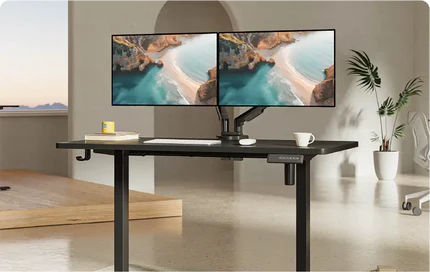A good monitor arm makes a real difference when you're working with dual monitors. It keeps your screens at the right height, frees up desk space, and lets you adjust your displays whenever you need to. Whether you write code, design graphics, or just need more screen space, having your monitors properly supported helps you work better and more comfortably. This guide will show you how to pick a monitor arm that fits your workspace, matches your needs, and stays within your budget.
How to Check What You Need Before Buying
Getting the right monitor arm starts with measuring your space and knowing your work habits. These checks will save you from buying the wrong mount and help you find one that fits perfectly.
Check Your Daily Monitor Usage
Different jobs require specific monitor positions. Graphic designers need to rotate screens between portrait and landscape modes. Data analysts keep screens at fixed angles for spreadsheet work. Video editors place screens side by side for timeline editing. Programmers often set one screen vertical for code reading and one horizontal for testing.
Track Your Monitor Movement Needs
Count how many times you:
- Adjust screen positions each day
- Share screens during meetings
- Switch between sitting and standing work
Your movement needs will decide between basic fixed arms or fully adjustable models.
Measure Your Desk Space
Get these exact measurements ready:
- Desk depth: ___ inches
- Desk width: ___ inches
- Desk thickness: ___ inches (most clamps fit 0.4-3.5 inches)
- Distance to nearest wall: ___ inches
- Location of power outlets
- Position of any desk holes
Pick Your Mount Type
Three mount options to choose from:
- Desk clamp: Attaches to desk edge, fits most desks
- Grommet mount: Goes through desk hole, very stable
- Wall mount: Attaches to wall studs, saves desk space
Note: Glass desks need special mounts. Check your desk material before buying.

Best Monitor Arm Features to Check Before Buying
The right monitor arm needs to match your screen specs and movement needs perfectly. A mismatch in any key feature could make the arm unstable or limit your work efficiency.
Monitor Size and Weight Limits
Every monitor arm has specific size and weight limits. Start by checking your monitor's VESA mount pattern - most use either 75x75mm or 100x100mm holes. Next, weigh your monitors or check their manuals. Most dual monitor arms handle 4.4-19.8 pounds per arm. Screen size matters too - standard arms work with 13-32 inch screens, but larger screens need heavy-duty models.
Movement Range You Need
Good monitor arms offer five key movements. You need up/down tilt (70 degrees) to fight glare and neck strain. Left/right swivel (180 degrees) helps when sharing your screen with colleagues. Full rotation (360 degrees) lets you switch between landscape and portrait modes. Height adjustment (minimum 10 inches) supports proper posture. The arm should also extend 15-25 inches from its mount to cover your desk depth.
Material and Design Quality
Quality materials prevent sagging and wobbling. Look for arms made from aircraft-grade aluminum or steel - they last longer and hold weight better. Built-in cable channels keep your desk tidy by hiding monitor wires. The joints should move smoothly and stay in place, with adjustable tension to handle different weights. The finish should resist scratches, and color options (usually black, silver, or white) help match your office style.
Pro tip: Monitor weight determines spring type. Heavier screens need gas or mechanical springs rated for their weight. Using an arm rated too light will cause your monitors to slowly sink during the day.

Monitor Arm Installation Guide
The right tools and proper setup ensure your monitor arm works safely and smoothly. A careful installation prevents damage to both your desk and monitors.
Tools and Parts You Need
Gather these essentials before starting:
- Phillips head screwdriver
- Allen wrench (usually included)
- Level tool
- Measuring tape
- Power drill (for wall mounts only)
- Someone to help lift heavy monitors
Step-by-Step Mount Installation
For Desk Clamp:
- Mark clamp position on desk edge
- Insert protective pad under clamp
- Tighten clamp firmly but not over-tight
- Attach vertical pole and arm segments
- Test arm movement before adding monitors
For Grommet Mount:
- Locate or drill desk hole (1.5-3 inch diameter)
- Insert base plate through hole
- Secure mounting plate under desk
- Attach arm components
- Check stability before mounting screens
For Wall Mount:
- Find and mark wall studs
- Drill pilot holes at correct height
- Attach wall plate with proper anchors
- Connect arm segments
- Test weight capacity before adding monitors
Cable Management Tips
Keep your setup clean and professional:
- Route cables through built-in channels
- Use included cable clips or ties
- Leave slack for full arm movement
- Group power and display cables separately
- Add cable sleeves for extra protection
The installation process might seem complex at first glance, but these systematic steps make it manageable. A properly installed monitor arm will provide years of stable, flexible monitor positioning and a clean, professional desk setup.
Advanced Monitor Arm Features
Modern monitor arms pack sophisticated features that enhance your work experience. The right combination of these features can transform a basic mounting solution into a highly efficient workspace tool.
Spring and Gas Lift Systems
Premium monitor arms use either mechanical springs or gas lift mechanisms for smooth movement. Gas lifts excel at maintaining consistent tension throughout their range, making monitor adjustments nearly effortless. Spring systems offer similar benefits but often cost less. Both systems include tension adjustment to fine-tune the counterbalance force for your specific monitor weight.
Multi-Monitor Expansion Options
Today's monitor arms often support future workspace expansion. Many single-monitor arms include mounting points for adding a second arm later. Some manufacturers offer modular systems where additional arms snap onto the existing pole. The best systems maintain stability even when fully loaded with multiple screens.
Quick-Release Mechanisms
Advanced arms feature tool-free monitor mounting systems. These quick-release mechanisms let users attach or remove monitors in seconds without screwdrivers. The VESA plate typically includes a safety lock to prevent accidental detachment. This feature proves invaluable during office reconfigurations or when switching between different monitor setups.

Monitor Arm Price Guide and Selection
Finding the right price point is crucial for getting a monitor arm that meets your needs. This section helps you make informed decisions within your budget.
How to Choose Under $100
Entry-level arms offer basic height and tilt adjustments with standard VESA mounting. These are suitable for fixed positions with occasional angle adjustments. Check these essential features:
- Weight capacity matching your monitor
- Clamp stability and desk protection
- Smooth operation of basic joints
- Essential cable management options
What You Get in $200-300 Range
Mid-range products offer valuable upgrades worth considering:
- All-metal construction
- Gas spring or mechanical assist
- Full 360-degree rotation
- Reinforced bearing systems
- Quick-release mechanisms
Key Points in Warranty Assessment
Before purchase, carefully examine:
- Length of full coverage warranty
- Parts replacement policy
- Technical support response time
- Common issues in user reviews
- Service center availability
A quality monitor arm is a long-term investment in productivity. Mid-range options typically offer the best balance between build quality and value, without unnecessary premium features.
Get Your Perfect Monitor Arm Setup!
Before buying your monitor arm, check your desk measurements, monitor weights, and daily movement needs. Choose between basic models under $100 for simple setups or mid-range options ($200-300) for better build quality and smoother adjustments. Focus on essential features that match how you actually work, rather than paying extra for features you won't use. A well-chosen monitor arm will help you work more comfortably and keep your desk organized for years to come.



Share:
Work Tips: Time Management (2)
Benefits of Combining Monitor Arms with Standing Desks